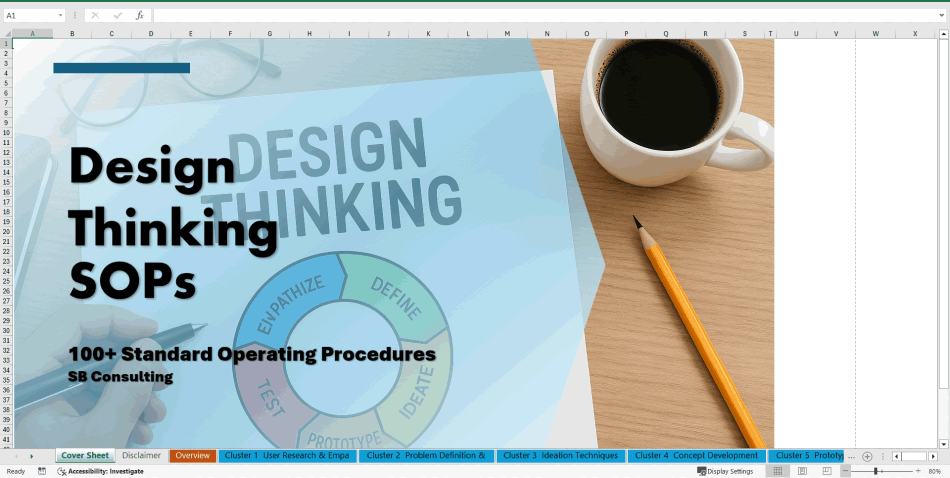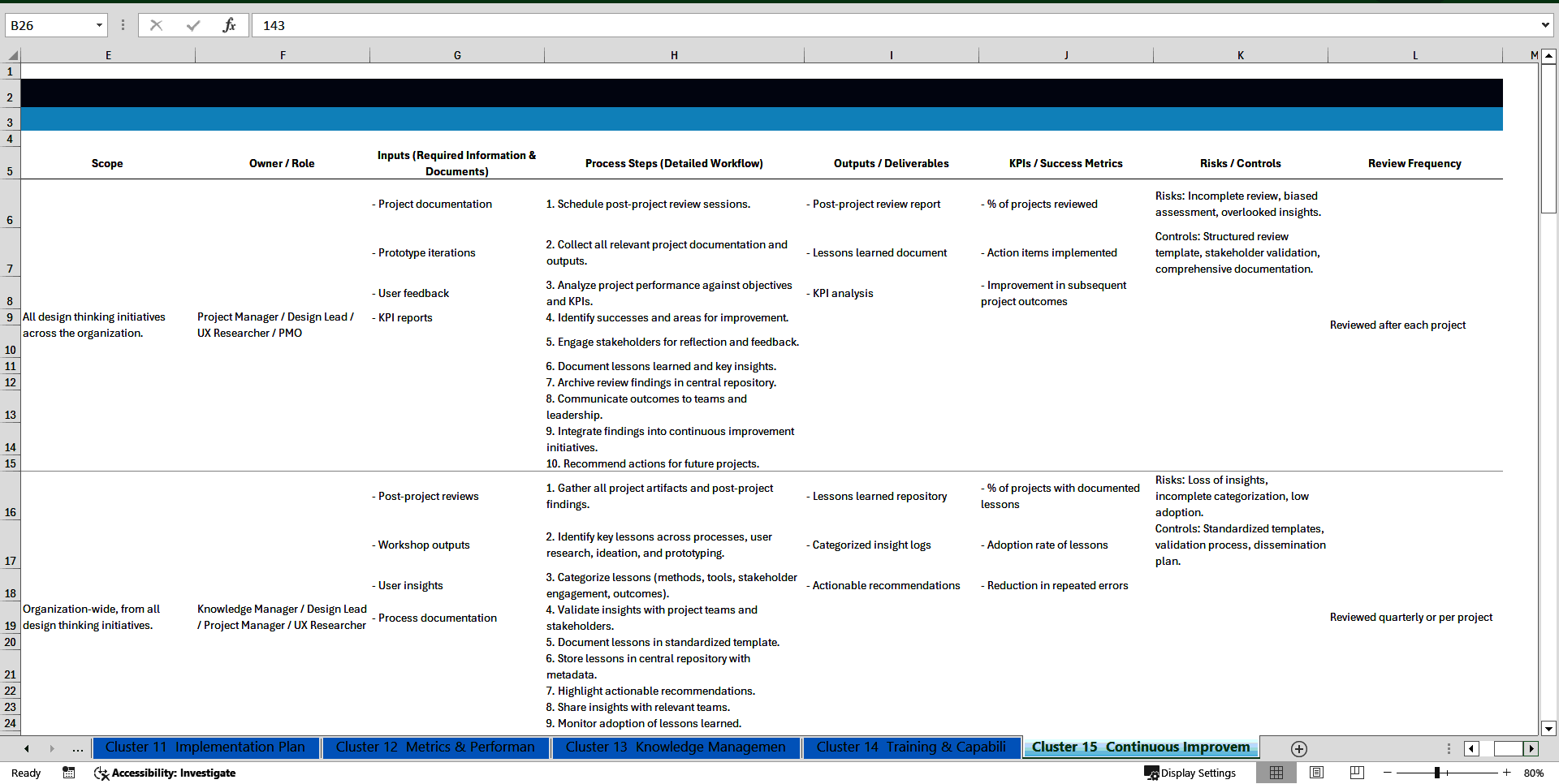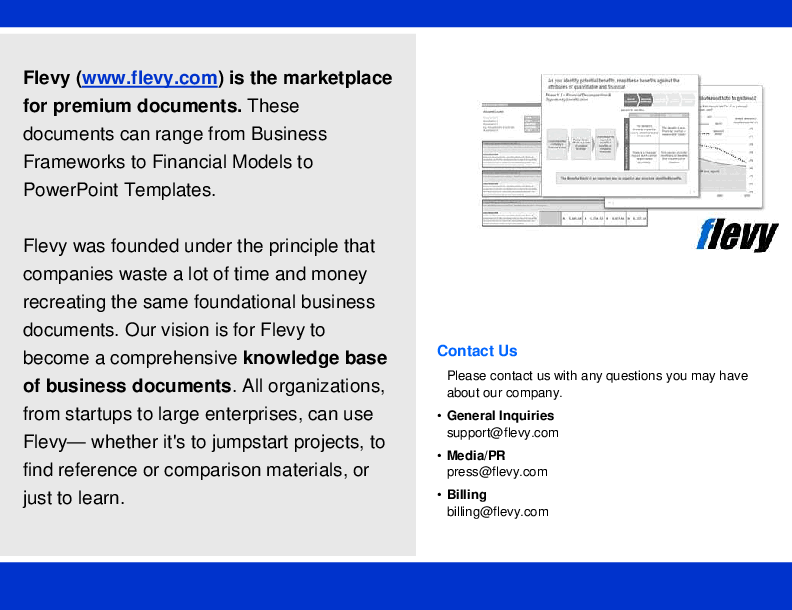100+ Design Thinking SOPs (Excel XLSX)
Excel (XLSX)
BENEFITS OF THIS EXCEL DOCUMENT
- Provides a step-by-step roadmap for conducting comprehensive user research and building accurate personas.
- Guides teams through structured ideation sessions to generate innovative solutions efficiently.
- Offers a clear framework for prototyping, testing, and validating concepts with real user feedback.
SERVICE DESIGN EXCEL DESCRIPTION
Curated by McKinsey-trained Executives
Unlock the Ultimate Design Thinking Productivity Toolkit with Our 100+ SOPs Excel Package!
Are you ready to revolutionize your design thinking process and skyrocket your team's innovation efficiency? Introducing the most comprehensive Design Thinking SOPs package available online, meticulously curated to cover every step of the design thinking journey—from User Research & Empathy to Continuous Improvement & Scaling. This all-in-one Excel template gives you 150 actionable Standard Operating Procedures (SOPs) across 15 clusters, empowering teams, designers, product managers, and innovation leaders to implement Design Thinking at scale, faster and smarter.
Our SOPs are designed for maximum clarity and impact, helping you streamline your processes, reduce iteration time, and achieve measurable results. Whether you're mapping customer journeys, facilitating brainstorming sessions, building prototypes, or implementing continuous improvement, these SOPs guide you step-by-step—saving weeks of trial-and-error planning.
Why Our Design Thinking SOPs Excel Package Is a Game-Changer:
• Over 150 SOPs organized across 15 core clusters
• Excel-ready templates for instant adoption and integration
• Covers the entire Design Thinking lifecycle, from empathy to scaling
• Optimized for teams, consultants, and innovation hubs
• Includes advanced practices like co-creation workshops, innovation roadmaps, and KPI tracking
Here's a full breakdown of all the 150+ Design Thinking SOPs included in this powerful package:
Cluster 1: User Research & Empathy
1. Conduct Stakeholder Interviews
2. Develop User Personas
3. Map Customer Journeys
4. Perform Contextual Inquiry
5. Conduct Ethnographic Observations
6. Facilitate Focus Groups
7. Create Empathy Maps
8. Conduct Shadowing Sessions
9. Gather User Feedback via Surveys
10. Analyze User Pain Points
Cluster 2: Problem Definition & Framing
11. Define Problem Statements
12. Develop "How Might We" Questions
13. Conduct Root Cause Analysis
14. Align Stakeholders on Problem Scope
15. Map Current State Processes
16. Perform SWOT Analysis
17. Identify Key User Needs
18. Develop Point-of-View Statements
19. Prioritize Problems by Impact
20. Validate Problem Hypotheses
Cluster 3: Ideation Techniques
21. Facilitate Brainstorming Sessions
22. Conduct Brainwriting Sessions
23. Run SCAMPER Exercises
24. Conduct Mind Mapping Workshops
25. Facilitate Crazy 8s Ideation
26. Perform Storyboarding for Ideas
27. Organize Idea Clustering & Affinity Mapping
28. Use Role-Playing for Ideation
29. Conduct Analogous Inspiration Sessions
30. Facilitate Dot Voting for Idea Prioritization
Cluster 4: Concept Development
31. Create Concept Sketches
32. Develop Low-Fidelity Prototypes
33. Build Paper Prototypes
34. Create Digital Wireframes
35. Develop Experience Blueprints
36. Validate Concept Feasibility
37. Conduct Concept Prioritization
38. Map Concept-to-User Journey Fit
39. Refine Concepts Iteratively
40. Align Concepts with Business Goals
Cluster 5: Prototyping & Experimentation
41. Build Interactive Prototypes
42. Use Rapid Prototyping Tools
43. Test Multiple Prototype Variants
44. Conduct Usability Testing
45. Perform A/B Prototype Testing
46. Document Prototype Feedback
47. Iterate Based on User Insights
48. Conduct Low-Fidelity Pilot Runs
49. Develop Clickable Mockups
50. Integrate Feedback into Prototype Evolution
Cluster 6: Testing & Validation
51. Plan User Testing Sessions
52. Conduct Heuristic Evaluations
53. Run Pilot User Trials
54. Perform Task Analysis
55. Measure Usability Metrics
56. Collect Qualitative User Feedback
57. Conduct Quantitative User Testing
58. Analyze Test Results for Patterns
59. Validate Solution Fit to Problem
60. Adjust Design Based on Test Outcomes
Cluster 7: Design & Visual Communication
61. Apply Visual Design Principles
62. Develop Mood Boards
63. Create Style Guides
64. Map Information Architecture
65. Design Intuitive UI/UX
66. Conduct Accessibility Reviews
67. Apply Branding Consistency
68. Create Storyboards for Experiences
69. Visualize Complex Processes
70. Use Prototyping Tools for Visuals
Cluster 8: Co-Creation & Collaboration
71. Facilitate Co-Creation Workshops
72. Use Cross-Functional Teams
73. Employ Collaborative Brainstorming Techniques
74. Conduct Stakeholder Alignment Sessions
75. Document Team Ideation Output
76. Enable Remote Collaboration Tools
77. Encourage Multidisciplinary Feedback
78. Run Collaborative Prioritization Exercises
79. Facilitate Open Innovation Sessions
80. Manage Design Thinking Sprints
Cluster 9: Innovation & Strategic Alignment
81. Align Solutions with Business Strategy
82. Conduct Trend & Market Analysis
83. Evaluate Competitive Benchmarking
84. Map Strategic Opportunities
85. Conduct Feasibility Assessments
86. Identify Innovation Gaps
87. Prioritize Opportunities by ROI
88. Develop Value Proposition Canvas
89. Integrate User Insights into Strategy
90. Create Innovation Roadmaps
Cluster 10: Decision-Making & Prioritization
91. Apply Impact-Effort Matrix
92. Use MoSCoW Prioritization
93. Conduct Risk-Reward Analysis
94. Facilitate Decision-Making Workshops
95. Rank Ideas by Strategic Fit
96. Establish Evaluation Criteria
97. Conduct Cost-Benefit Analysis
98. Validate Decisions with Stakeholders
99. Apply Evidence-Based Decision Techniques
100. Document Decision Rationale
Cluster 11: Implementation Planning
101. Develop Implementation Roadmaps
102. Define Action Plans & Milestones
103. Assign Roles & Responsibilities
104. Integrate Design Thinking into Project Plans
105. Map Dependencies & Risks
106. Develop Resource Allocation Plans
107. Conduct Change Readiness Assessments
108. Establish Success Metrics
109. Plan Continuous Feedback Loops
110. Monitor Implementation Progress
Cluster 12: Metrics & Performance
111. Define KPIs for Design Thinking Initiatives
112. Measure User Satisfaction
113. Track Adoption Metrics
114. Measure Time-to-Market Improvements
115. Monitor Prototype Iteration Cycles
116. Conduct ROI Analysis for Solutions
117. Evaluate Innovation Impact
118. Measure Collaboration Effectiveness
119. Track Problem Resolution Rates
120. Benchmark Against Industry Standards
Cluster 13: Knowledge Management & Documentation
121. Maintain Design Thinking Repository
122. Document Workshop Outputs
123. Capture User Insights & Learnings
124. Archive Prototypes & Test Results
125. Maintain Version Control of Concepts
126. Record Process Improvements
127. Develop Case Studies of Success Stories
128. Share Lessons Learned Across Teams
129. Organize Ideation & Prototype Artifacts
130. Standardize Documentation Templates
Cluster 14: Training & Capability Building
131. Develop Design Thinking Training Programs
132. Conduct Internal Workshops
133. Mentor Cross-Functional Teams
134. Promote Human-Centered Mindset
135. Train on Prototyping Tools
136. Facilitate Continuous Learning Sessions
137. Evaluate Team Skill Development
138. Encourage Peer-to-Peer Learning
139. Maintain a Learning Community of Practice
140. Certify Internal Design Thinking Practitioners
Cluster 15: Continuous Improvement & Scaling
141. Conduct Post-Project Reviews
142. Identify Lessons Learned
143. Implement Feedback Loops
144. Scale Successful Solutions
145. Institutionalize Best Practices
146. Conduct Process Optimization Audits
147. Monitor Industry Trends for Updates
148. Maintain Innovation Pipelines
149. Evaluate Organizational Design Thinking Maturity
150. Drive Culture of Continuous Innovation
Get your 100+ Design Thinking SOPs Excel Package today and instantly transform your ideation, prototyping, testing, and implementation process into a highly efficient, scalable, and measurable innovation engine. Stop guessing, start executing, and watch your team deliver breakthrough solutions faster than ever before!
Key Words:
Strategy & Transformation, Growth Strategy, Strategic Planning, Strategy Frameworks, Innovation Management, Pricing Strategy, Core Competencies, Strategy Development, Business Transformation, Marketing Plan Development, Product Strategy, Breakout Strategy, Competitive Advantage, Mission, Vision, Values, Strategy Deployment & Execution, Innovation, Vision Statement, Core Competencies Analysis, Corporate Strategy, Product Launch Strategy, BMI, Blue Ocean Strategy, Breakthrough Strategy, Business Model Innovation, Business Strategy Example, Corporate Transformation, Critical Success Factors, Customer Segmentation, Customer Value Proposition, Distinctive Capabilities, Enterprise Performance Management, KPI, Key Performance Indicators, Market Analysis, Market Entry Example, Market Entry Plan, Market Intelligence, Market Research, Market Segmentation, Market Sizing, Marketing, Michael Porter's Value Chain, Organizational Transformation, Performance Management, Performance Measurement, Platform Strategy, Product Go-to-Market Strategy, Reorganization, Restructuring, SWOT, SWOT Analysis, Service 4.0, Service Strategy, Service Transformation, Strategic Analysis, Strategic Plan Example, Strategy Deployment, Strategy Execution, Strategy Frameworks Compilation, Strategy Methodologies, Strategy Report Example, Value Chain, Value Chain Analysis, Value Innovation, Value Proposition, Vision Statement, Corporate Strategy, Business Development, Busienss plan pdf, business plan, PDF, Biusiness Plan DOC, Bisiness Plan Template, PPT, Market strategy playbook, strategic market planning, competitive analysis tools, market segmentation frameworks, growth strategy templates, product positioning strategy, market execution toolkit, strategic alignment playbook, KPI and OKR frameworks, business growth strategy guide, cross-functional strategy templates, market risk management, market strategy PowerPoint dec, guide, ebook, e-book ,McKinsey Change Playbook, Organizational change management toolkit, Change management frameworks 2025, Influence model for change, Change leadership strategies, Behavioral change in organizations, Change management PowerPoint templates, Transformational leadership in change, supply chain KPIs, supply chain KPI toolkit, supply chain PowerPoint template, logistics KPIs, procurement KPIs, inventory management KPIs, supply chain performance metrics, manufacturing KPIs, supply chain dashboard, supply chain strategy KPIs, reverse logistics KPIs, sustainability KPIs in supply chain, financial supply chain KPIs, warehouse KPIs, digital supply chain KPIs, 1200 KPIs, supply chain scorecard, KPI examples, supply chain templates, Corporate Finance SOPs, Finance SOP Excel Template, CFO Toolkit, Finance Department Procedures, Financial Planning SOPs, Treasury SOPs, Accounts Payable SOPs, Accounts Receivable SOPs, General Ledger SOPs, Accounting Policies Template, Internal Controls SOPs, Finance Process Standardization, Finance Operating Procedures, Finance Department Excel Template, FP&A Process Documentation, Corporate Finance Template, Finance SOP Toolkit, CFO Process Templates, Accounting SOP Package, Tax Compliance SOPs, Financial Risk Management Procedures.
NOTE: Our digital products are sold on an "as is" basis, making returns and refunds unavailable post-download. Please preview and inquire before purchasing. Please contact us before purchasing if you have any questions! This policy aligns with the standard Flevy Terms of Usage.
Got a question about the product? Email us at support@flevy.com or ask the author directly by using the "Ask the Author a Question" form. If you cannot view the preview above this document description, go here to view the large preview instead.
Source: Best Practices in Service Design Excel: 100+ Design Thinking SOPs Excel (XLSX) Spreadsheet, SB Consulting








